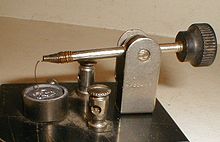Our website is made possible by displaying online advertisements to our visitors.
Please consider supporting us by disabling your ad blocker.
Crystal detector


A crystal detector is an obsolete electronic component used in some early 20th century radio receivers that consists of a piece of crystalline mineral which rectifies the alternating current radio signal.[1] It was employed as a detector (demodulator) to extract the audio modulation signal from the modulated carrier, to produce the sound in the earphones.[2] It was the first type of semiconductor diode,[3] and one of the first semiconductor electronic devices.[4] The most common type was the so-called cat's whisker detector, which consisted of a piece of crystalline mineral, usually galena (lead sulfide), with a fine wire touching its surface.[1][4][5]
The "asymmetric conduction" of electric current across electrical contacts between a crystal and a metal was discovered in 1874 by Karl Ferdinand Braun.[6] Crystals were first used as radio wave detectors in 1894 by Jagadish Chandra Bose in his microwave experiments.[7][8] Bose first patented a crystal detector in 1901.[9] The crystal detector was developed into a practical radio component mainly by G. W. Pickard,[4][10][11] who discovered crystal rectification in 1902 and found hundreds of crystalline substances that could be used in forming rectifying junctions.[2][12] The physical principles by which they worked were not understood at the time they were used,[13] but subsequent research into these primitive point contact semiconductor junctions in the 1930s and 1940s led to the development of modern semiconductor electronics.[1][4][14][15]
The unamplified radio receivers that used crystal detectors are called crystal radios.[16] The crystal radio was the first type of radio receiver that was used by the general public,[14] and became the most widely used type of radio until the 1920s.[17] It became obsolete with the development of vacuum tube receivers around 1920,[1][14] but continued to be used until World War II and remains a common educational project today thanks to its simple design.
- ^ a b c d Cite error: The named reference
Braunwas invoked but never defined (see the help page). - ^ a b Cite error: The named reference
Sievers1was invoked but never defined (see the help page). - ^ Cite error: The named reference
Hickmanwas invoked but never defined (see the help page). - ^ a b c d Lee, Thomas H. (2004). Planar Microwave Engineering: A Practical Guide to Theory, Measurement, and Circuits, Vol. 1. Cambridge University Press. pp. 4–9, 297–300. ISBN 978-0521835268.
- ^ U.S. patent 1,104,073 Greenleaf Whittier Pickard, Detector for Wireless Telegraphy and Telephony, filed: 21 June 1911, granted: 21 July 1914
- ^ Orton, John W. (2004). The Story of Semiconductors. Oxford University Press. pp. 20–23. ISBN 978-0198530831.
- ^ Seitz, Frederick; Einspruch, Norman (4 May 1998). The Tangled History of Silicon in Electronics. Silicon Materials Science and Technology: Proceedings of the Eighth International Symposium on Silicon Materials Science and Technology, Vol. 1. San Diego: The Electrochemical Society. pp. 73–74. ISBN 9781566771931. Retrieved 27 June 2018.
- ^ although at the microwave frequencies he used these detectors did not function as rectifying semiconductor diodes like later crystal detectors, but as a thermal detector called a bolometer. Lee, Thomas H. (2004). Planar Microwave Engineering: A Practical Guide to Theory, Measurement, and Circuits, Vol. 1. Cambridge University Press. pp. 4–5. ISBN 978-0521835268.
- ^ U.S. patent 755,840 Jagadis Chunder Bose, Detector for Electrical Disturbances, filed: 30 September 1901, granted 29 March 1904
- ^ U.S. patent 836,531 Greenleaf Whittier Pickard, Means for Receiving Intelligence Communicated by Electric Waves, filed: 30 August 1906, granted: 20 November 1906
- ^ Douglas, Alan (April 1981). "The Crystal Detector". IEEE Spectrum. 18 (4): 64–69. doi:10.1109/MSPEC.1981.6369482. hdl:10366/158938. ISSN 0018-9235. S2CID 44288637. archived: part1, part2, part3, part4
- ^ Pickard, Greenleaf Whittier (August 1919). "How I Invented the Crystal Detector" (PDF). Electrical Experimenter. 7 (4): 325–330, 360. Retrieved 13 June 2016.
- ^ Riordan, Michael; Lillian Hoddeson (1988). Crystal fire: the invention of the transistor and the birth of the information age. USA: W. W. Norton & Company. pp. 19–21, 92. ISBN 978-0-393-31851-7.
- ^ a b c Basalla, George (1988). The Evolution of Technology. UK: Cambridge University Press. pp. 44–45. ISBN 978-0-521-29681-6.
- ^ Winston, Brian (2016). Misunderstanding Media. Routledge. pp. 256–259. ISBN 978-1315512198.
- ^ Sterling, Christopher H.; O'Del, Cary (2010). The Concise Encyclopedia of American Radio. Routledge. pp. 199–201. ISBN 978-1135176846.
- ^ "...crystal detectors have been used [in receivers] in greater numbers than any other [type of detector] since about 1907." Marriott, Robert H. (September 17, 1915). "United States Radio Development". Proceedings of the Institute of Radio Engineers. 5 (3): 184. doi:10.1109/jrproc.1917.217311. S2CID 51644366. Retrieved 2010-01-19.
Previous Page Next Page


